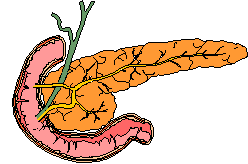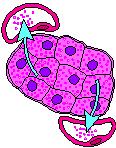The human pancreas is an amazing organ with two main functions: [1] to produce
pancreatic endocrine hormones (e.g., insulin
& glucagon) which help regulate many aspects
of our metabolism and [2], to produce pancreatic digestive
enzymes. Pancreatic production of insulin, somatostatin,
gastrin, and glucagon plays an important role in maintaining
sugar and salt balance in our bodies and therefore any problem
in the production or regulation of these hormones will manifest
itself with problems with blood sugar and fluid / salt imbalances.
The digestive portion of the pancreas makes up more than
90 percent of its total cell mass. The digestive (or
exocrine) pancreas is responsible for making digestive enzymes
which are secreted into the intestines to help digest (break
down) the food we eat. These enzymes digest proteins,
fats, and carbohydrates into much smaller molecules so our
intestines can absorb them. The picture below is an
accurate representation of the pancreas which lies next
to the duodenum (the first part of the small intestine right
after the stomach). The actual size of the pancreas is similar
to a banana which has been stepped on...it has a slight
curve to it, and its about the same length, width, and thickness.
The yellow "tube" running through the middle of
the pancreas is called the pancreatic duct. It drains
all the digestive enzymes from the pancreatic cells where
they are made into the duodenum where they mix with food
as it comes out of the stomach.

The Endocrine Pancreas
Approximately 5 percent of the total pancreatic mass is
comprised of endocrine cells. These endocrine cells
are clustered in groups within the pancreas which look like
little islands of cells when examined under a microscope.
This appearance led to these groups of pancreatic endocrine
cells being called "Pancreatic Islets".
Within pancreatic islets are cells which make specific pancreatic
endocrine hormones, of which there are only a few (the most
famous of course being insulin). These cells within
the islets are called "Pancreatic Islet Cells".
Pancreatic islets are scattered throughout the pancreas.
Like all endocrine glands, they secrete their hormones into
the bloodstream and not into tubes or ducts like the digestive
pancreas. Because of this need to secrete their hormones
into the blood stream, pancreatic islets are surrounded
by small blood vessels. This relationship is shown
in the picture of a pancreatic islet where islet cells are
secreting their hormones into nearby blood vessels.
Remember, the purpose of endocrine cells is to make hormones
which are secreted into the blood stream where they gain
access to other cells very far away with the goal of making
those cells respond in a specific fashion.

Pancreatic Endocrine Hormones
and Their Purpose
Insulin
Purpose: Regulate blood glucose
(sugar) in the normal range
Action: Forces many cells of the body
to absorb and use glucose thereby decreasing blood sugar
levels
Secreted in response to: High blood glucose
Secretion inhibited by: Low blood glucose
Disease due to deficient action: Diabetes
Disease due to excess action: Hypoglycemia
Tumor called: Insulinoma.
Glucagon
Purpose: Assist insulin in regulating
blood glucose (sugar) in the normal range (actions are opposite
of insulin)
Action: Forces many cells of the body
to release (or produce) glucose (increasing blood sugar)
Secreted in response to: Low blood glucose
Secretion inhibited by: High blood glucose
Disease due to deficient action: Some
times nothing, sometimes hypoglycemia
Disease due to excess action: Hyperglycemia
Tumor called: Glucagonoma
Somatostatin
Purpose: Regulate the production and excretion
of other endocrine tumors
Action: Slows down production of insulin,
glucagon, gastrin, and other endocrine tumors
Secreted in response to: High levels
of other endocrine hormones
Secretion inhibited by: Low levels of
other endocrine hormones
Disease due to deficient action: Poorly
defined
Disease due to excess action: Diabetes
(inhibits insulin production), gallstones, and dietary fat
intolerance.
Tumor called: Somatostatinoma
Gastrin
Purpose: Assist in digestion within the
stomach
Action: Induce acid producing cells of
the stomach to produce acid
Secreted in response to: Food in the
stomach and intestines
Secretion inhibited by: Absence of food
in stomach and intestines
Disease due to deficient action: Poorly
defined, some times no symptoms at all
Disease due to excess action: Stomach
ulcers due to excess stomach acid
Tumor called: Gastrinoma (also called
Zollinger Ellison Syndrome)
Vasoactive Intestinal Peptide
(VIP)
Purpose: Help control water secretion
and absorption from the intestines
Action: Causes intestinal sells to secrete
water and salts into the intestines (inhibit absorption)
Secreted in response to: Unclear
Secretion inhibited by: Unclear
Disease due to deficient action: No symptoms
at all
Disease due to excess action: Severe
watery diarrhea and salt (potassium) imbalances
Tumor called: VIPoma
Ref. and for
more information: http://www.endocrineweb.com/pancreas.html